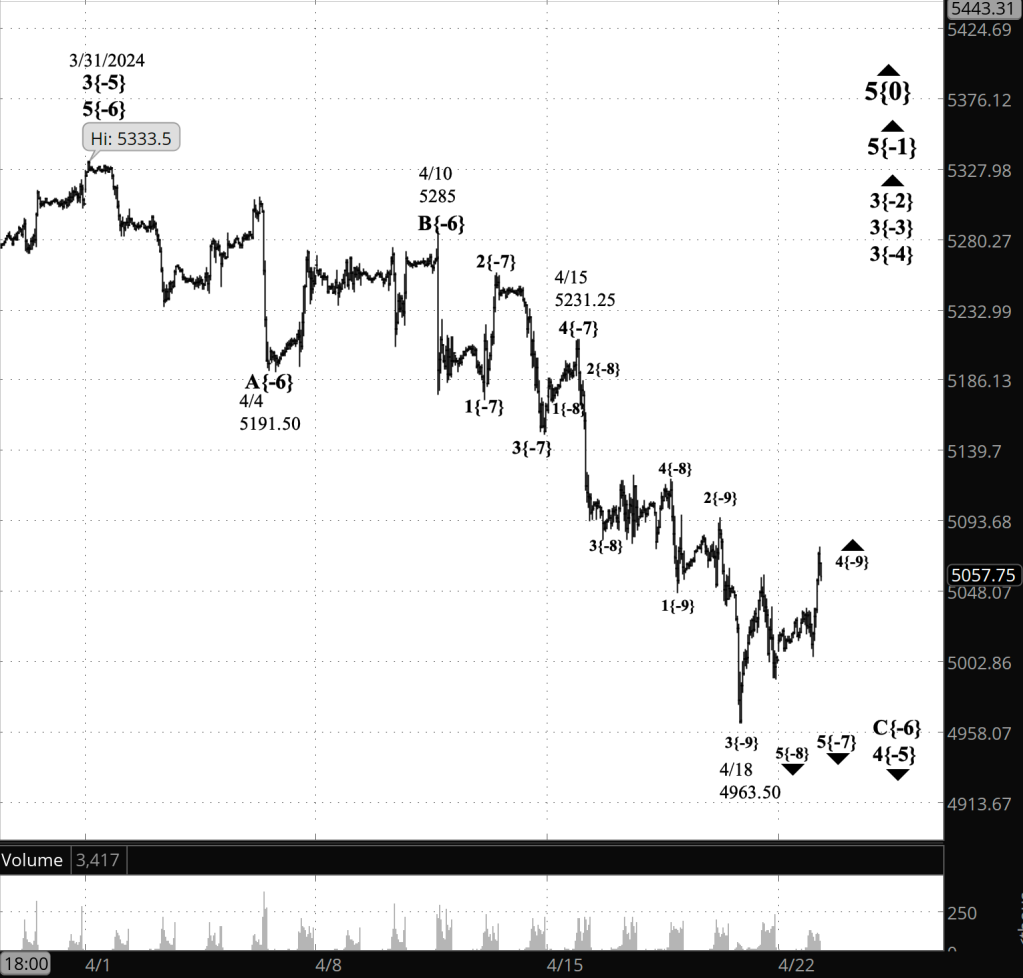3:30 p.m. New York time
Half an hour before the closing bell. The S&P 500 futures continued to rise during the session, reaching into the 5270s. In Elliott Wave Theory, the rise is the third and final subwave, wave C{-10}, within the upward correction that began on April 18, wave 4{-9}, is underway. It may have ended at the session peak, or maybe not.
I’ve updated the chart.
9:35 a.m. New York time
What’s happening now? The S&P 500 E-mini futures rose gradually after trading resumed overnight, from just below 5010 into the 5030s.
What does it mean? Elliott Wave Theory views the rise is a low-degree 4th-wave upward correction buried deep within the final subwave, wave C, of a much larger downward correction that began on March 31. The smaller wave, which began on April 18, is in its 3rd of five subwaves. The smllert 4th wave will be followed by a downtrending 5th wave that will complete the correction and also two downtrending 5th degrees, each one degree higher.
Move one degree higher, the end of those 5th waves will also trigger the end of the final subwave of the larger correction. A 5th-wave uptrend will follow and likely will last for weeks before reaching its end, which will trigger a still larger 4th-wave downward correction.
That’s a long way of saying that all of those waves are interconnected, each a part of a complex fractal structure. When one wave reaches its end, even a relatively small one like the 4th wave that began on April 18, the event sends shockwaves up and down the fractal structure.
The fractal structure behaves like the Butterfly Effect in Chaos Theory — “When a butterfly flutters its wings in one part of the world, it can eventually cause a hurricane in another,” as the mathematician and meteorologist Edward Norton Lorenz put it.
See the “What does Elliott Wave Theory say?” section bellow for an inventory of waves now underway, with subscripts in curly brackets denoting the waves relation to Intermediate degree.
What are the alternatives? Friday’s alternative — that the low-degree 4th wave has ended and the rising 5th wave has begun — seems less likely, given the subwave structure, although I can’t rule it out entirely.

[S&P 500 E-mini futures at 3:30 p.m., 40-minute bars, with volume]
What does Elliott wave theory say? Here are the waves that underly the analyses.
Principal Analysis:
- Rising wave 5{0} is underway. It is a wave of Intermediate Degree that began in December 2018.
- It is in its final subwave, wave 5{-1}
- Within wave 5{-1}, rising waves 3{-2}, 3{-3} and 3{-4} are underway, as is the smallest wave labeled on the chart, wave 4{-5}.
- Downtrending wave 4{-5} is in its final subwave, falling wave C{-6}, which is in its last subwave, falling wave 5{-7}.
- Within wave 5{-7}, wave 5{-8} is underway and is in its next-to-the-last subwave, wave 4{-9}.
We Are Here.
These are the waves currently in progress under my principal analysis. Each line on the list shows the wave number, with the subscript in curly brackets, the traditional degree name, the starting date, the starting price of the S&P 500 E-mini futures, and the direction of the wave.
- S&P 500 Index:
- 5{+3} Supercycle, 7/8/1932, 4.40 (up)
- 5{+2} Cycle, 12/9/1974, 60.96 (up)
- 5{+1} Primary, 3/6/2009, 666.79 (up)
- 5{0} Intermediate, 12/26/2018, 2346.58 (up)
- S&P 500 Futures and index:
- 5{-1} Minor, 10/13/2022, 3502 (up) (futures), 3491.58 (up) (index)
- S&P 500 Futures:
Reading the chart. Price movements — waves – – in Elliott wave analysis are labeled with numbers within trending waves and letters with corrective waves. The subscripts — numbers in curly brackets — designate the wave’s degree, which, in Elliott wave analysis, means the relative position of a wave within the larger and smaller structures that make up the chart. R.N. Elliott, who in the 1930s developed the form of analysis that bears his name, viewed the chart as a complex structure of smaller waves nested within larger waves, which in turn are nested within still larger waves. In mathematics it’s called a fractal structure, where at every scale the pattern is similar to the others.
Learning and other resources. Elliott wave analysis provides context, not prophecy. As the 20th century semanticist Alfred Korzybski put it in his book Science and Sanity (1933), “The map is not the territory … The only usefulness of a map depends on similarity of structure between the empirical world and the map.” And I would add, in the ever-changing markets, we can judge that similarity of structure only after the fact.
See the menu page Analytical Methods for a rundown on where to go for information on Elliott wave analysis.
By Tim Bovee, Portland, Oregon, April 22, 2024
Disclaimer
Tim Bovee, Private Trader tracks the analysis and trades of a private trader for his own accounts. Nothing in this blog constitutes a recommendation to buy or sell stocks, options or any other financial instrument. The only purpose of this blog is to provide education and entertainment.
No trader is ever 100 percent successful in his or her trades. Trading in the stock and option markets is risky and uncertain. Each trader must make trading decisions for his or her own account, and take responsibility for the consequences.
All content on Tim Bovee, Private Trader by Timothy K. Bovee is licensed under a Creative Commons Attribution-ShareAlike 4.0 International License.
Based on a work at www.timbovee.com.

You must be logged in to post a comment.